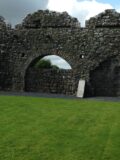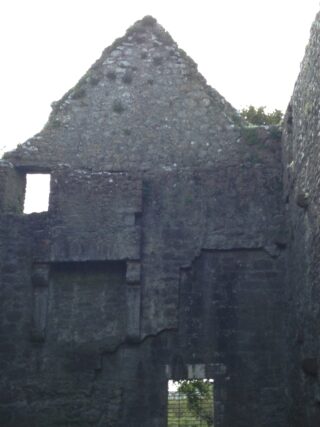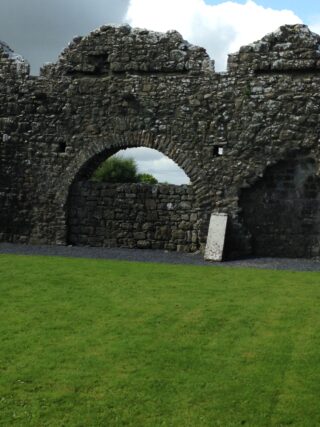Fógra
WARNING: It should be noted that these sites are unguided and a level of care and caution should be maintained during all stages of your visit. The Office Of Public Works (OPW) will not be held responsible for any damages, injuries, or losses that occur
Claregalway Franciscan Friary
Claregalway Abbey is a nave and chancel church founded by Norman knight John de Cogan for the Franciscan friars. De Cogan founded Claregalway in c.1240, and by 1252 had received a license to have a weekly market and annual fair. The church dates from the 13th to the 15th century. In the late 13th/early 14th century, the Abbey was protected by the Irish lords of the region, the O’Flaherty’s. By the 16th century it was the Earls of Clanricard protecting the friars. The dissolution of the monasteries saw the friary sacked by crown forces who raided and plundered the site of all value. In 1570 Richard Burke, 2nd Earl of Clanricarde, was granted Claregalway Abbey, only to have the Lord President of Connaught, Sir Richard Bingham, take their territory in 1589. Bingham converted Claregalway Abbey into a barracks in 1589 for his forces, ejecting the friars. The abbey was regranted back to the Earls of Clanricarde, with the friars returning in the early 17th century. At the end of 1847 the last two friars had left Claregalway Abbey.
The north transept, aisle and three-storey tower all date to the 15th century. The original entrance was via the west gable through a pointed arched doorway with overhead traceried window. The nave was separated from the church by a four-pointed arch and within the nave are three tomb-niches and a piscina. The chancel has six pairs of lancet windows, dated to the 13th century, with a large traceried window in the east gable dated to the 15th century. The chancel houses a piscina, aumbry, sedilia and the tomb niche of the de Burgos. This is a canopied niche with short half columns, moulded capitals of small heads, dating to the 1400’s. A wall monument set into the niche bears the Burke coat of arms, and has a Latin inscription dedicated to the de Burgos, dated 1646. Graveslabs, both inscribed and plain, are found within the church and date from the 13th to 17th centuries. In the southern portion of the site the cloister and domestic buildings are found, and further south again leads to the garderobes and watermill.
Visit Historic Environment Viewer for more information on Claregalway Abbey
Protect our Past - Click here to read about the importance of protecting our country’s unique heritage sites
This national monument is protected in accordance with the National Monuments Acts 1930 to 2014
Gailearaí
Suíomhanna cóngarach
Caisleán Bhaile Átha an Rí
Suaitheantas de thiarnas na Normannach
Timpeall 14.3 km ón
Caisleán Achadh na nIúr
Seoid stairiúil i gcroílár Chonamara
Timpeall 23.4 km ón
Ionad Cultúrtha an Phiarsaigh Conamara - Teach an Phiarsaigh agus Ionad Cuairteoirí
Teachín ar maos sa stair réabhlóideach agus i gcultúr na nGael
Timpeall 44.9 km ón
Mainistir na hInse
Féach le haoibhneas ar shnoiteáin fhíoráille na hAthbheochana
Timpeall 55.7 km ón
Caisleán agus Gairdíní Phort Omna
Breáthacht ón seachtú haois déag ar bhruacha Loch Deirgeirt
Timpeall 56.2 km ón
Caisleán Ros Comáin - Túr Thiar Theas
Caisleán Normannach drámatúil, taibhseach, ón tríú haois déag
Timpeall 59.0 km ón



